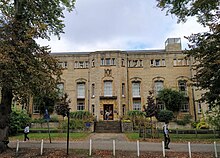Department of Plant Sciences, University of Oxford
 The Department of Biology, South Parks Road, which was formerly known as the Department of Plant Sciences. | |
| Merged into | Department of Zoology |
|---|---|
| Successor | Department of Biology |
| Dissolved | 2022 |
| Website | www |
The Department of Plant Sciences, at the
Herbaria
The department housed the Oxford University
- Fielding-Druce Herbarium.
- Daubeny Herbarium.
In total the collections contain 800,000 specimens
History
Forestry was an important part of the university under the name of the Imperial Forestry Institute, from 1924;[4][5] later the Commonwealth Forestry Institute from 1939.[6] The Oxford Forestry Institute was incorporated into the Department of Plant Sciences in 2002,[7] and research relating to forestry was undertaken under that name until 2022 when the department merged with the Department of Zoology to form the Department of Biology.[1] Some students were Imperial Forest Service students, who came from many parts of the British Empire to qualify as foresters before they returned home.[8] It ran a post graduate MSc forestry course for many years: Forestry and its Relation to Land Use,[9] until 2002.[7]
In January 2021, the
See also
References
- ^ a b "Oxford launches new department to further bioscience teaching and research | University of Oxford". ox.ac.uk. August 2022. Retrieved 15 August 2022.
- ^ Bloom, Michael. "26 November 2015 – Oxford University Herbarium". abnats.org.uk. Retrieved 6 September 2017.
- ^ "Oxford Plant Systematics". Herbaria.plants.ox.ac.uk. Retrieved 26 August 2015.
- doi:10.1038/137573a0.
- doi:10.1038/139731a0.
- ISBN 978-0-19-822974-2
- ^ . Retrieved 29 December 2017.
- ^ Excerpta e statutis universitatis Oxoniensis: titulus XIV, de vestitu et habitu scholastico; titulus XV, de moribus conformandis; titulus XXIII, of women students. Oxonii: e Prelo Clarendoniano, [1925], pp. 374-75
- ^ [1] Archived 3 July 2007 at the Wayback Machine
- ^ "The Life and Mind Building". lifeandmind.web.ox.ac.uk.
- ^ Lowe2021-01-21T06:00:00+00:00, Tom. "Wates gets planning green light for Oxford uni's biggest ever project". Building. Retrieved 10 February 2021.
{{cite web}}: CS1 maint: numeric names: authors list (link) - ^ a b "University of Oxford's £200m life sciences building plan approved". BBC News. 21 January 2021. Retrieved 10 February 2021.
